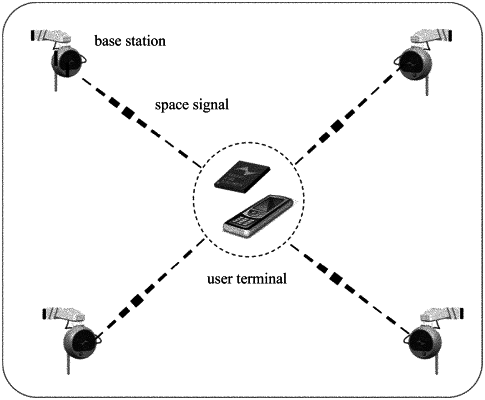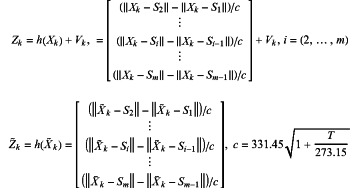| CPC G01S 5/22 (2013.01) | 6 Claims |

|
1. An acoustic positioning method for a smartphone and a wearable device, wherein the acoustic positioning method for the smartphone and the wearable device comprises:
transmitting a ranging signal by virtue of a base station network, receiving and decoding the ranging signal by virtue of a user terminal, estimating distances from base stations to the user terminal according to first arrival signals, and estimating the position of a user according to a plurality of distances measured on the position of the user;
wherein the acoustic positioning method for the smartphone and the wearable device comprises the following steps:
step 1, designing Chirp signals of which the frequencies are 12 kHz to 21 kHz;
step 2, performing precise ranging based on acoustic waves; and
step 3, performing positioning based on acoustic ranging and an inertial sensor;
wherein performing positioning based on acoustic ranging and an inertial sensor in the step 3 further comprises:
by applying a sliding window program to the measurement of an IMU of which the step length is 10 Hz, obtaining the output rate, which is 20 Hz, of a learned velocity vector, wherein a displacement vector is estimated by multiplying a time interval of two continuous periods t1 and t2 by the velocity vector and is expressed as follows:
 collecting measured values of a distance and an azimuth from absolute coordinates, and estimating the position of the user by using a 2D method;
fusing the displacement vector obtained from a PDR network by adopting the extended Kalman filter, wherein the displacement vector is located in local coordinates L(x, y, u) defined by an initial heading x and a vertical direction u, and the y axis is defined under the action of right-handed Cartesian coordinates; as final coordinates output by the EKF are in navigation coordinates G(e, n, u) defined in an east, north, up direction, forming, by the two coordinates G and L, a rotation angle θ on a horizontal plane: introducing the rotation angle θ to a state vector of the filter as follows:
 wherein [ek,nk] are respectively horizontal coordinates in east and north directions within an epoch k: θk comprises a rotation angle between the coordinates G and L and an accumulated drift error of the gyroscope: a state transition equation of a system is described as follows:
 wherein Xk is a predicted state vector: Wk is process noise subject to normal distribution N(0, Qk), and Qk is a covariance matrix of the process noise; and Δxk and Δyk are displacement components in the local coordinates L from a period k-1 to a period k obtained by a data-driven PDR network;
synchronizing clocks among all the signal transmitters by using a 433 MHz radio frequency, and achieving a synchronization error which is smaller than 0.1 ms; if the ranging signal is received from the plurality of signal transmitters, using a plurality of TDoA observation data, wherein an observation equation Zk is expressed as:
 wherein h(*) is an observed transition matrix, Zk is a vector of a predicted observed value calculated by using the predicted state vector Xk, S is a coordinate vector of an ith transmitter in the coordinates G, Vk, is an error vector of Zk, and Zk is subject to normal distribution N(0, Rk) wherein Rk is a covariance matrix of Zk, m is the number of the transmitters available on the current position of the user, and c is a sound velocity at the temperature T;
updating the EKF as:
Pk=FkPk-1FkT+Qk
Kk=PkHkT(HkPkHkT+Rk)−1
Xk=Xk+Kk(Zk−Zk)
Pk=(I−KkHk)Pk,
wherein Fk=∂h/∂Xk, Hk=∂h/∂Xk, Xk is state estimation, Pk is a predicated covariance matrix, Pk is an updated covariance matrix, Kk is a Kalman gain, and I is a unit vector.
|